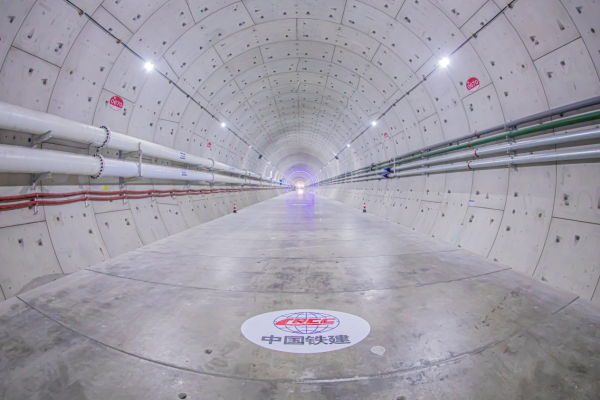On May 29, the “Yongzhou” tunnel boring machine (TBM), operated by the China Railway 14th Bureau Group Corporation Limited, a subsidiary of China Railway Construction Corporation Limited (CRCC), successfully penetrated the seabed section of the Jintang Undersea Tunnel on the Ningbo side, reaching a depth of 64 meters underground.
This breakthrough marks the full-scale launch of undersea construction of the world’s longest undersea high-speed railway tunnel.
The Jintang Undersea Tunnel will connect Jintang Islet in Zhoushan to the coastal region of Ningbo in Zhejiang Province, covering a distance of 16.18 kilometers, with an 11.2-kilometer section requiring drilling.
Construction employs two TBMs launching simultaneously from both the Ningbo and Zhoushan sides. The Ningbo section, undertaken by China Railway 14th Bureau Group Corporation Limited, is 4,940 meters long and is being excavated eastward using the “Yongzhou” TBM, which has a cutting diameter of 14.57 meters.

Tunnel section on the Ningbo side of the Jintang Undersea Tunnel [Photo/sasac.gov.cn]
The seabed geology between Ningbo and Zhoushan is highly variable and complex. The tunnel passes beneath multiple risk points such as oil pipelines, seawalls, docks, and shipping channels. At its deepest, it lies 78 meters below the seabed, subjected to maximum water pressure of 8.4 bars — equivalent to nearly one ton of force on the surface area of a human palm. Over the entire length of the tunnel, the alignment transitions 28 times between soft and hard strata. The “Yongzhou” TBM must negotiate 24 of these changes, with uneven and hard rock conditions accounting for nearly 70 percent of the stretch. The hardest rock reaches a compressive strength of nearly 200 MPa. This long-distance excavation across highly variable geology demands frequent tool changes under high pressure and is among the most technically challenging tunneling endeavors globally.
Since its launch, the “Yongzhou” TBM has successfully overcome over 10 major transitions between soft and hard strata, completing 2,020 meters of excavation.
The TBM will descend over a 2,920-meter subsea section under high water pressure exceeding 6 bars until reaching the undersea breakthrough point. To withstand the long distance and high-pressure environment, the project team has significantly reinforced the TBM’s sealing systems. A dual-shell design has been adopted, with four layers of enhanced tail brushes, increasing the TBM’s pressure resistance to 12 bars — enhancing its performance in extreme subsea conditions.
The Ningbo-Zhoushan Railway starts at Ningbo East Railway Station and ends in Baiquan Town, Dinghai District, Zhoushan. The 76.4-kilometer-long line is designed for a maximum speed of 250 kilometers per hour. It primarily serves medium- and long-distance tourist passengers while also accommodating intercity travel between Zhoushan and Ningbo.
(Executive editor: Cui Feng)